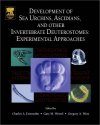![Development of Invertebrate Deuterostomes Development of Invertebrate Deuterostomes]()
Click to have a closer look
About this book
Contents
Biography
Related titles
About this book
This book provides a practical guide to experimental methods for studying the development of invertebrate deuterostomes, such as sea urchins, ascidians, hemichordates, and amphioxus. These model organisms are of contemporary and historical importance to the study of developmental biology, particularly genomic research. The chapters provide detailed experimental protocols that cover a broad range of topics in modern experimental methods. Topics covered range from rearing embryos to the care of adult animals, while also presenting the basic experimental methods including light and electron microscopy, used to study gene expression, transgenics, reverse genetics, and genomic approaches. It covers a wide range of methods, from classical embryology through modern genomics. It discusses animals related to vertebrates, providing a valuable evolutionary perspective. It includes a practical guide to the use of sea urchins in the teaching laboratory.
Contents
Overview: Echinoderms and other invertebrate deuterostomes as experimental material for the study of cell and developmental biology; I. Procurement, Maintenance and Culture of Oocytes, Embryos, Larvae, and Adults; Care and maintenance of adult echinoderms (species, breeding seasons, suppliers, care and handling, aquarium maintenance,large-scale aquaculture); Echinoderm eggs and embryos: Procurement and culture (small and large scale); Culture of echinoderm larvae through metamorphosis; Isolation and maturation of echinoderm oocytes; Procurement and culture of ascidian embryos; Culture of adult ascidians and ascidian genetics; Hemichordate embryos - procurement, culture, and basic methods; Cephalochordate embryos - procurement, culture, and basic methods. II. Embryological Approaches; Microinjection into eggs, blastomeres, and the blastocoel; Blastomere isolation and transplantation; Isolation and culture of micromeres and PMCs; Transplantation and ablation of cells at later stages; Cell adhesion assays. III. Cell Biological Approaches; Immunostaining; Light microscopy of embryos; Electron microscopy of embryos; Calcium imaging; Imaging components of cells with fluorescent probes; Isolating extracellular matrices; Isolating organelles; Measuring ion fluxes in gametes. IV. Molecular Biological Approaches; Isolating DNA, RNA, polysomes, and protein; m-RNA detection by in situ hybridization and RT-PCR; Using reporters to study cis-regulatory elements; Nuclear extracts, footprinting mobility shift assays, affinity purification; Expression of exogenous mRNAs; Disruption of gene function using antisense morpholinos and function-blocking antibodies; Generation and use of transgenic ascidian embryos. V. Genomics; Genomic resources for echinoderms: Sequence databases, arrayed libraries and filters; Genomic resources for ascidians: Sequence/expression databases and genome projects; Gene network analysis. VI. Echinoderm Eggs and Embryos in the Teaching Lab; Simple and reliable laboratory exercises. VII. Appendices.
Customer Reviews
Biography
Edited by Dr. Charles E. Ettensohn, Dr. Gary M. Wessel and Dr. Gregory Wray




































